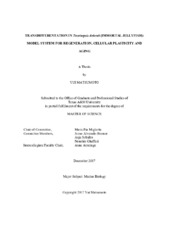| dc.description.abstract | Turritopsis dohrnii (Cnidaria, Hydrozoa) undergoes life cycle reversal to avoid
death caused by physical damage, adverse environmental conditions, or aging. This
unique ability has granted the species the name, the “Immortal Jellyfish”. T. dohrnii
exhibits an additional developmental stage to the typical hydrozoan life cycle which
provides a new paradigm to further understand regeneration, cellular plasticity and
aging. Weakened jellyfish will undergo a whole-body transformation into a cluster of
uncharacterized tissue (cyst stage) and then metamorphoses back into an earlier life
cycle stage, the polyp. The underlying cellular processes that permit its reverse
development is called transdifferentiation, a mechanism in which a fully mature and
differentiated cell can switch into a new cell type. It was hypothesized that the unique
characteristics of the cyst would be mirrored by differential gene expression patterns
when compared to the jellyfish and polyp stages. Specifically, it was predicted that the
gene categories exhibiting significant differential expression may play a large role in the
reverse development and transdifferentiation in T. dohrnii.
The polyp, jellyfish and cyst stage of T. dohrnii were sequenced through RNAsequencing,
and the transcriptomes were assembled de novo, and then annotated to
create the gene expression profile of each stage. Comparative functional gene
enrichment analyses with the cyst as the central stage of comparison reported significant
GO categories that were over-expressed, such as telomere maintenance and DNA repair,
in the cyst as compared to other stages. The enrichment analyses also reported
significantly under-expressed categories, such as mitotic cell division and cellular
differentiation, in the cyst as compared to the other stages. Additionally, candidate
genes, such as the Yamanaka (Oct4, Sox2, Klf4, c-Myc) and Thompson Factors (Lin28,
Nanog) that exhibit potential association with the transdifferentiation processes were
found among the three stages for downstream differential gene expression analyses.
Ultimately, our work produced a foundation to develop an alternative model system to
further investigate and comprehend regeneration, cellular plasticity and aging in
metazoans. | en |


